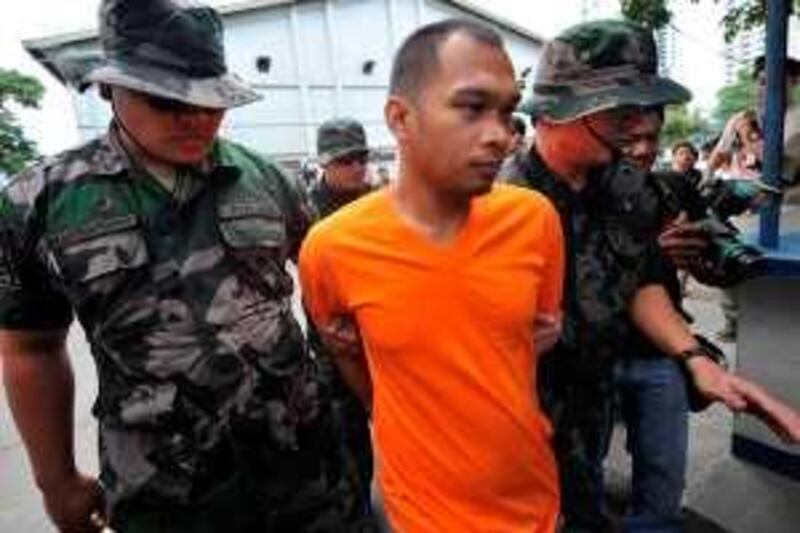MANILA // While the death of the Abu Sayyaf leader Albader Parad was hailed as a major victory in the Philippine government's battle against Islamic militants, analysts say only the alleviation of poverty in the areas where the insurgency is taking place will see an end to violence.
Poverty and disenfranchisement, the say, are the root causes of terrorism and insurgency in Mindanao and the Sulu archipelago and the implementation of programmes to reduce poverty and give young Muslims a sense of hope for the future would be the best remedy. "Unless basic development programmes are implemented and socio-economic progress is experienced across the immediate region, the conflict will persist," said Pete Troilo, a director with Pacific Strategies & Assessments, a political risk consultancy in Manila.
He said that while the death of Parad was a major coup for the Philippine military it will do very little to "change the playing field". Rommel Banlaoi, executive director of the Philippine Institute for Peace, Violence and Terrorism Research, agreed, adding that Parad was not such a significant player in the Abu Sayyaf that his death will lead to the group's demise. "His only claim to fame really was last year when he kidnapped three Red Cross workers in Sulu. Before that he had been a low-key figure," he said.
Other senior members are still going strong, he said. "Isnilon Hapilon and Radullan Sahiron are still active and can still wreak havoc. The Abu Sayyaf Group is a very resilient organisation that has the ability to change color from terrorism to banditry and vice versa. "There are many young Muslims in the south lured to the Abu Sayyaf just to escape poverty." He said the group last year was behind a number of high-profile kidnappings and is today flush with money making it an "attractive employer".
Lt Col Romeo Brawner, armed forces spokesman, said on Monday it will only be a matter of time before someone replaces Parad. Parad and five of his men were killed when a special operations group from the Philippine Marines attacked an Abu Sayyaf camp on the island of Jolo in the Sulu archipelago. Parad's body has been identified by civilians in the area, but results of a DNA test have yet to be released.
Military and police in Mindanao and Metro Manila have been placed on heightened alert following last Sunday's attack fearing possible retaliatory attacks by Parad's followers. Although there is no specific intelligence to suggest there will be an attack, the security forces usually issues alerts following major encounters with insurgent groups when senior figures are killed or captured. Of the original 24 Abu Sayyaf leaders, 12 are alive today.
Founded in 1991 in Basilan province, the group at one stage received funding from al Qa'eda but after the terrorist attacks on New York and the Pentagon on September 11, 2001, funding was cut off. Since then the group has fragmented into at least 14 different factions, according to Mr Banlaoi. Sahiron is one of the oldest of the original members and is believed to be in his 70s. But according to US intelligence reports, nothing has been seen or heard of him since 2008. The US government has a US$100,000 (Dh367,000) bounty for his capture.
Hapilon, 44, has been out of the picture for a number of years and according to US intelligence reports he may have had a stroke. The US government has a $5 million bounty for his capture. Since 2001 the United States has maintained up to 600 Special Forces troops in the southern Philippines primarily for intelligence gathering and training Filipino soldiers in counter-insurgency. Although the Philippine military has had some gains against the Abu Sayyaf it still remains a resilient enemy despite the death and capture of some of its senior figures.
"The Abu Sayyaf's ability to persevere can be attributed to its decentralised and networked structure," Mr Troilo said. "The various factions within the group can independently be linked with other militants, generate funds, plan and execute terrorist attacks all amidst a generally sympathetic Muslim populace." Although the Philippine government puts the total strength of the Abu Sayyaf at between 300 and 400, Mr Troilo said recruits are never hard to find.
"Not in Mindanao or Sulu which is full of alienated and disenchanted young Muslims with few education and employment opportunities," he said. Mr Troilo said the fundamental problem is poverty and a "sense of alienation among Muslim youth". One of the country's more prominent politicians, Senator Richard Gordon, who is running for president, agreed, saying poverty was a key issue in solving the insurgency.
"There is no room for empty promises," he said. He said that unless there was effective governance in the region poverty would continue and "without effective governance, the dream of seeing an end to the war that has plagued this country for decades, will remain a pipedream." foreign.desk@thenational.ae





